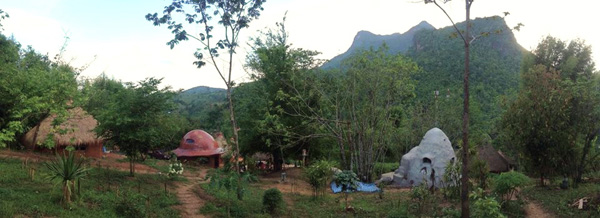
Numerous structures have been built with rice hulls over the years. We’ve previous reported on the Rice Hull B&B and Paul’s Rice Hull Earthbag House. Up till now we’ve had little to no feedback on their effectiveness over time, particularly when it comes to moisture damage. Richard Gingris who’s been reporting on projects at New Life Foundation forwarded me the following email discussion with Maggi at Chiang Dao Roundhouses B&B. With this positive feedback from Maggi, Richard will be recommending building with rice hull bags at New Life in the future.
“Hi Maggi,have you had any challenges with moisture, rotting or mold using rice hulls? Have you had any issues with rodents or pests that might want to nest in the rice hulls?”
Richard
“Hi Richard, the rice husks (hulls) dry out very well, mine were rained on a number of times before they were put into walls. My house is husks without any mud plaster (no time!) and I have been here for over a year. The husks draw the moisture from the air keeping the room dry compared to outside. I have had rodents etc, but cats help with that. However, once the mud plasters are on the walls there are no rodents and also, if there are leaks (which I have had in the roof) the husks dry themselves out over time. I am delighted with them! They are fast to build with and very good insulation. I have no idea how they will work over time – no one has used them for very long. We shall see!
Below is my blog where you can see the work we have done step by step.
Let me know if you have any more questions.”
Best wishes, Maggi
Chiang Dao Roundhouses B&B
Blog: http://maggimck.wordpress.com
Tip: Add a plastic drape (strip of plastic sheeting) along the top of the wall so roof leaks will not directly penetrate the rice hulls. This is also good building practice for earthbag walls. It’s best to put it under the bond beam.
Tip: Rice hull bags, scoria bags and other bags or tubes of loose fill material will likely need some reinforcing to stabilize the walls. Check out this blog post Earthbag Scoria Casita. Their YouTube channel shows in detail how to stabilize buildings made with loose fill materials.

From Maggi’s blog:
We plan to hold a workshop in the new year, end of February 2015, for people who would like to learn how to build one of our unique rice-husk-bag and earth domes. The workshop will last about 10 days and will be limited to 10 people. If you are interested and would like more details, email me at maggimck@yahoo.com.
And the best news of all: the B&B is OPEN for business! Come and stay!
http://www.chiangdao-roundhouses.com
So this is really great news for folks who have rice hulls to work with. I’ve been hesitant to endorse this approach too strongly because there was no long term feedback. The good news is rice hulls aren’t as vulnerable as I’d thought. You still want to protect the rice hulls as much as possible. Special thanks to Maggi and Richard for their help.